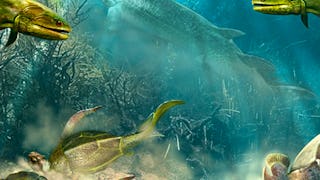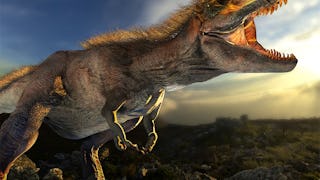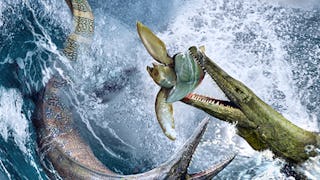Paleontology: Theropod Dinosaurs and the Origin of Birds is a five-lesson course teaching a comprehensive overview of the origins of birds. This course examines the anatomy, diversity, and evolution of theropod dinosaurs in relation to the origin of birds. Students explore various hypotheses for the origin of flight. Watch a preview of the course here: https://uofa.ualberta.ca/courses/paleontology-theropod-dinosaurs

5 days left: Get a Black Friday boost with $160 off 10,000+ programs. Save now.


Paleontology: Theropod Dinosaurs and the Origin of Birds

Instructor: Philip John Currie, Ph.D
Top Instructor
32,552 already enrolled
Included with
(1,567 reviews)
Skills you'll gain
Details to know

Add to your LinkedIn profile
5 assignments
See how employees at top companies are mastering in-demand skills

There are 5 modules in this course
In Lesson 1, we explore the anatomy and adaptations of birds, and meet the Victorian scientists who first suspected the link between the terrible lizards and modern birds. In order to fly, birds have undergone a series of anatomical specializations that distinguishes them from other vertebrates. However, many of the most striking and anatomically unusual traits of birds originated over 230 million years ago with the very first theropod dinosaurs. Just a quick note before you get started: 'Palaios' is the Greek word for 'ancient', so palaeontology or paleontology is the study of ancient life. Both spellings are correct, with palaeontology used in Britain, and paleontology more common in the US.
What's included
3 videos6 readings1 assignment
In the wake of the Permian mass extinction, the prehistoric world was ripe for the taking. All the world’s landmass was consolidated into the single supercontinent: Pangaea. With no seas standing in their way, new terrestrial animal lineages were able to exploit new habitats all across the globe. Archosaurs, meaning ‘ruling reptiles’, came to dominate Triassic ecosystems. However, dinosaurian archosaurs were not the top predators. Instead, crurotarsans sat undisputed at the top of the food chain. The first theropods were small, but agile carnivores, and although they started out as the Darwinian equivalent of the mail room clerks, by the next geological period (the Jurassic), they were large and in charge. In Lesson 2, we will introduce you to some of the earliest theropods, and explore the anatomical secrets to their survival and eventual success. We will also meet the largest land predators of all time.
What's included
3 videos1 reading1 assignment
In the previous lesson, we explored how the various theropod lineages adapted to their role as apex predators. In this lesson, we will explore a new group of theropods, as much characterized by their speed and agility as their predatory prowess. The coelurosaurs were the most successful and diverse of all the theropods, and included herbivores, the smallest of all dinosaurs, and, of course, the mighty tyrannosaurs.
What's included
4 videos1 reading1 assignment
Dinosaurs had long been thought of as overgrown reptiles; cold blooded, swamp bound, with meagre intelligence and little to no social complexity. The ‘Dinosaur Renaissance’ was a revolution in palaeontological thinking that entirely transformed that traditional image of dinosaurs. In Lesson 4, we will see how new research and discoveries over the past fifty years have shaped our modern image of dinosaurs into one of energetic, intelligent animals, that likely displayed many of the complex social behaviours witnessed in modern birds. You’ll also meet the deinonychosaurs, A.K.A. ‘the raptors’, and you will learn the leading theories for how one group of dinosaurs learned to fly.
What's included
3 videos1 reading1 assignment
66 million years ago, an asteroid the larger than Mt. Everest collided with the earth and brought about the extinction of the dinosaurs…except birds! Now that you’re familiar with some of their larger Mesozoic ancestors and their bird-like features, it’s time to meet the avian lineage proper. With the evolution of flight, birds could exploit habitats and resources that were literally unreachable by other animals. The evolution of birds has been one of diversification. Flightlessness has evolved numerous times, as have specializations for insectivory, swimming, and predation. Although theropods may no longer dominate the land, they still rule the skies.
What's included
3 videos1 reading1 assignment
Instructor

Offered by
Explore more from Basic Science
 Status: Preview
Status: PreviewUniversity of Alberta
 Status: Preview
Status: PreviewAmerican Museum of Natural History
 Status: Free
Status: FreeUniversity of Alberta
 Status: Preview
Status: PreviewUniversity of Alberta
Why people choose Coursera for their career




Learner reviews
1,567 reviews
- 5 stars
91.07%
- 4 stars
7.84%
- 3 stars
0.95%
- 2 stars
0.06%
- 1 star
0.06%
Showing 3 of 1567
Reviewed on Mar 10, 2021
Excellent course! Very thorough. Very knowledgable presenters. Loved how well the course was laid out. I with there could be more interactive activities like the dinosaur foot!
Reviewed on Apr 19, 2020
Really well presented, content accessible for beginners and those with prior knowledge, and amazing course notes that can be downloaded to look at any time. Would highly recommend.
Reviewed on Oct 25, 2022
This course was packed full of interesting information. The only thing i would change is the length of individual classes. This could easily have been a 10 week course.

Open new doors with Coursera Plus
Unlimited access to 10,000+ world-class courses, hands-on projects, and job-ready certificate programs - all included in your subscription
Advance your career with an online degree
Earn a degree from world-class universities - 100% online
Join over 3,400 global companies that choose Coursera for Business
Upskill your employees to excel in the digital economy
Frequently asked questions
To access the course materials, assignments and to earn a Certificate, you will need to purchase the Certificate experience when you enroll in a course. You can try a Free Trial instead, or apply for Financial Aid. The course may offer 'Full Course, No Certificate' instead. This option lets you see all course materials, submit required assessments, and get a final grade. This also means that you will not be able to purchase a Certificate experience.
When you purchase a Certificate you get access to all course materials, including graded assignments. Upon completing the course, your electronic Certificate will be added to your Accomplishments page - from there, you can print your Certificate or add it to your LinkedIn profile.
Yes. In select learning programs, you can apply for financial aid or a scholarship if you can’t afford the enrollment fee. If fin aid or scholarship is available for your learning program selection, you’ll find a link to apply on the description page.
More questions
Financial aid available,

